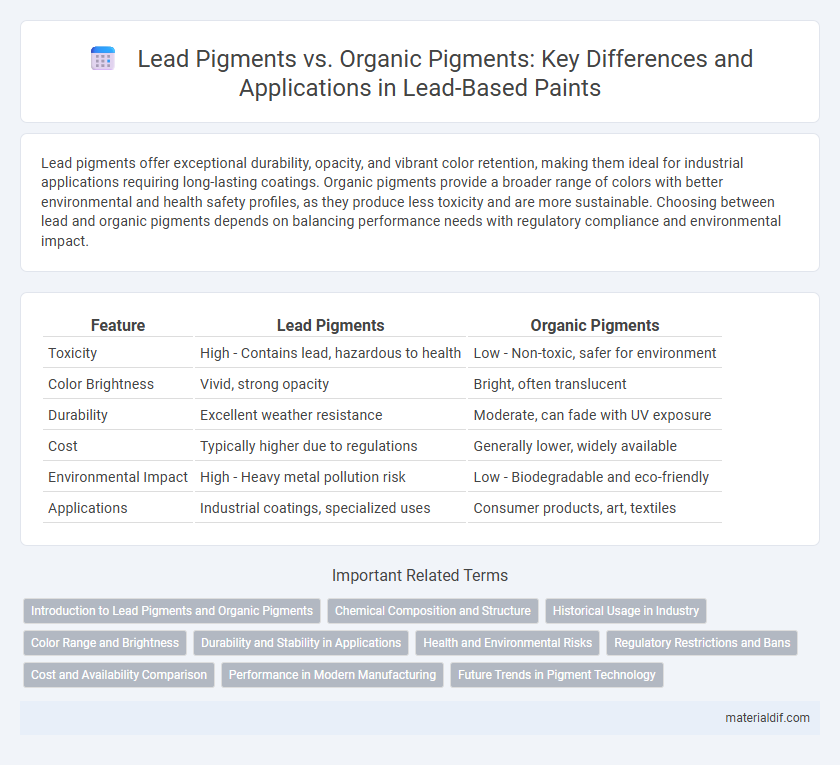Lead pigments offer exceptional durability, opacity, and vibrant color retention, making them ideal for industrial applications requiring long-lasting coatings. Organic pigments provide a broader range of colors with better environmental and health safety profiles, as they produce less toxicity and are more sustainable. Choosing between lead and organic pigments depends on balancing performance needs with regulatory compliance and environmental impact.
Table of Comparison
| Feature | Lead Pigments | Organic Pigments |
|---|---|---|
| Toxicity | High - Contains lead, hazardous to health | Low - Non-toxic, safer for environment |
| Color Brightness | Vivid, strong opacity | Bright, often translucent |
| Durability | Excellent weather resistance | Moderate, can fade with UV exposure |
| Cost | Typically higher due to regulations | Generally lower, widely available |
| Environmental Impact | High - Heavy metal pollution risk | Low - Biodegradable and eco-friendly |
| Applications | Industrial coatings, specialized uses | Consumer products, art, textiles |
Introduction to Lead Pigments and Organic Pigments
Lead pigments, known for their high opacity and durability, have historically been used in paints due to their excellent coverage and resistance to moisture. Organic pigments, derived from carbon-based molecules, offer vibrant colors and enhanced environmental safety compared to lead-based options. The choice between lead pigments and organic pigments involves balancing performance characteristics with health and ecological considerations.
Chemical Composition and Structure
Lead pigments primarily consist of inorganic lead compounds such as lead carbonate (PbCO3) and lead chromate (PbCrO4), characterized by their crystalline lattice structures that provide high opacity and durability. Organic pigments are based on carbon-containing molecules with complex aromatic structures and conjugated double bonds, offering vibrant colors but less coverage compared to lead pigments. The inorganic nature of lead pigments results in greater stability and resistance to light and chemicals, whereas organic pigments excel in color variety due to their molecular design.
Historical Usage in Industry
Lead pigments, such as lead white and chrome yellow, were historically predominant in industrial applications due to their opacity, brightness, and durability, especially in paints and coatings from the 18th to the early 20th century. Organic pigments emerged later, offering safer alternatives with vibrant colors derived from carbon-based molecules, reducing the health hazards associated with lead toxicity. The transition in industry favored organic pigments for environmental and regulatory reasons, while lead pigments remain studied for their unique chemical properties and historical significance in materials science.
Color Range and Brightness
Lead pigments offer a limited color range but excel in brightness and opacity, making them ideal for applications requiring intense, vivid tones. Organic pigments provide a broader spectrum of colors with greater versatility but generally exhibit lower brightness and opacity compared to lead-based options. The choice between lead and organic pigments depends on the desired balance between vibrant brightness and extensive color variety.
Durability and Stability in Applications
Lead pigments exhibit superior durability and chemical stability compared to organic pigments, making them ideal for long-lasting applications in industrial coatings and automotive paints. Their resistance to UV radiation, moisture, and temperature fluctuations ensures sustained color retention and minimal degradation over time. In contrast, organic pigments, while offering vibrant hues, often lack the same level of stability, leading to faster fading and reduced performance in harsh environmental conditions.
Health and Environmental Risks
Lead pigments, commonly used in paints, pose significant health risks due to lead's neurotoxicity, causing developmental disorders and cognitive impairments, especially in children. In contrast, organic pigments generally have lower toxicity and are less prone to environmental contamination, reducing risk to human health and ecosystems. However, the environmental persistence and complex chemical structures of some organic pigments may still require careful assessment to minimize ecological impact.
Regulatory Restrictions and Bans
Lead pigments face stringent regulatory restrictions and bans worldwide due to their toxic effects on human health and the environment, with agencies such as the US EPA and EU REACH enforcing limits or prohibitions. Organic pigments offer safer alternatives, being largely exempt from such heavy restrictions, which facilitates their widespread use across industries like automotive coatings and plastics. Regulatory frameworks continue to favor organic pigments over lead-based ones, driving innovation toward non-toxic, eco-friendly colorants.
Cost and Availability Comparison
Lead pigments generally offer superior durability and opacity but come at a higher cost due to regulatory restrictions and limited availability. Organic pigments, derived from carbon-based molecules, are more widely available and cost-effective, making them popular in consumer products. The price gap reflects differences in raw material sourcing, manufacturing complexity, and environmental compliance expenses.
Performance in Modern Manufacturing
Lead pigments offer superior opacity, durability, and resistance to weathering, making them highly effective in industrial coatings and automotive finishes. Organic pigments, although less durable, provide brighter colors and improved environmental safety, aligning with increasing regulatory standards in modern manufacturing. Manufacturers must balance the exceptional performance of lead pigments with the eco-friendly advantages of organic alternatives to meet industry demands.
Future Trends in Pigment Technology
Future trends in pigment technology emphasize the development of sustainable, non-toxic alternatives to traditional lead pigments due to increasing environmental and health regulations. Organic pigments are gaining momentum for their superior color vibrancy, lightfastness, and lower ecological impact, driven by innovations in bio-based synthesis and nanotechnology. Advancements in pigment formulations aim to balance durability and safety, positioning organic pigments as the forefront choice in next-generation coatings and plastics industries.
Lead Pigments vs Organic Pigments Infographic

 materialdif.com
materialdif.com